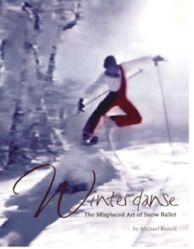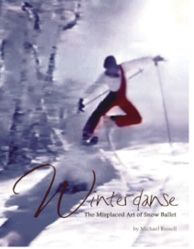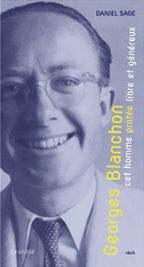ISHA Award books: Winterdanse, Georges Blanchon


Winterdanse: The Misplaced Art of Snow Ballet
by Michael Russell
Michael Russell’s Winterdanse is a passionate, cri du coeur about the author’s career in freestyle skiing - his triumphs, his failures and his struggles to have the purity of the artform acknowledged and accepted.
Freestyle skiing is an umbrella term (a loose one) that covers a number of styles of skiing, from acrobatic to moguls, skating to aerials, et al. It has been around for some time, dating back to at least the mid-1880s in Morgedal, Norway, where practitioners made “hopalom” and arabesques off moguls and in gates, per “Roots of an Olympic Sport: freestyle,” by Morten Lund with Peter Miller (Skiing Heritage, March 1998). Dr. Fritz Reuel in 1920s Austria continued this break from traditional skiing with his Reuel (Royal) Christies performed on the “wrong,” uphill, edge.
Winterdanse, however, is concerned with what occurred after the acceptance of “freestyle” as a legitimate form of skiing competition, which is generally agreed to have begun with the introduction of freestyle skiing instruction at Waterville Valley, New Hampshire, in 1969. The next year, Waterville owner Tom Corcoran and PSIA co-founder, and “exotic” skier, Doug Pfeiffer organized the first National Open Championships of Freestyle Skiing.
Russell, in Winterdanse, acknowledges Pfeiffer’s seminal influence on the directions his life took in skiing. In this story of his personal journey, from 1973 through 1985, the author takes us from his first tentative steps experimenting with “exotic skiing,” found in his father’s collection of Doug Pfeiffer Skiing magazine pointers, at Pat’s Peak, NH. He begins as a gifted amateur who showed creative mixing of acrobatic moves, choreographed to music combinations he chose. He distained aerials as not sufficiently artistic.
He joined the Chevy Tour as a professional in 1975, and was soon competing with the likes of Ed Pouquette, Greg Athans, Bob Theobold and Greg Stump. Russell from the beginning thought of his freestyle as actually “ballet skiing,” and accordingly developed routines that were imaginative, dynamic and flowing. He began to modify his equipment, changing the flex of his ski tips, the placement of his bindings and progressing through longer and longer ski poles that gave him leverage, for example, to execute the first ballet 720s on skis.
Russell takes us through his dozen years in the sport, pushing the balletic envelope, struggling against the rigidity of many judges and an increasing move in the sport towards “confining” the artform and the establishment of fixed and defined moves - all to make it more digestible and categorizable for the judging panels.
Amply and handsomely illustrated with classic photographs and documented with newspaper clippings, copies of score sheets and hand-drawn choreographic layouts, this is one of the first, if not the first, comprehensively reported works on the development of the freestyle movement, its growing pains, its eventual acceptance as an Olympic event and, ultimately, its original form falling from grace in the world of skiing competition. Winterdanse is an important contribution to the history of skiing and its possibilities. - Bob Soden
Winterdanse: The Misplaced Art of Snow Ballet by Michael Russell, Published by Nonesmanneslond, U.S.A. (2022), hardcover, 336 pages. $44.00

George Blanchon
By Daniel Sage
Georges Blanchon is little-known outside France, but he was a founder of the Alpes-Club and of the national French Ski School, and a tremendously influential author and journalist. He deserves to be better-known. Daniel Sage has compiled a biography composed largely of Blanchon’s memoirs, providing valuable insight into the thoughts one of skiing’s pioneer organizers and builders.
In Georges Blanchon: cet homme protée libre et genereux (Georges Blanchon: this protean man, free and generous), Sage shows how Blanchon was fundamental, and key, to the formation of one of the first ski school organizations in Europe, and the creation of its ski instruction bible.
Blanchon was a polymath who, in 1918, at age 16, founded the Alpes-Club, and in 1925 taught himself journalism and began writing for Le Petit Dauphinois, then the daily newspaper of the French-speaking Alps. He would go on to work as a broadcaster, created an illustrated monthly magazine and then founded a real estate business in Grenoble. In 1930 he was elected secretary-general of the French Ski Federation (Fédération française de ski - FFS).
In 1937, Blanchon produced, with FIS champion Emile Allais and ski team captain Paul Gignoux, the seminal work Ski Français. Blanchon, with his writing and illustration skills, was responsible for producing the lion’s share of this historic book. That same year, Blanchon unified the various methods of ski teaching in France, and became the founding president the National French Ski School (l'École nationale du ski français - ENSF).
In 1939, Blanchon formed a partnership with Charlotte Perriand, an interior designer and architect, and set up a design office to produce military barracks. During the Second World War he joined the National Front for the Liberation and Independence of France and the resistance with the Francs-tireurs and French partisans. He was a captain in the Departmental Committee for the Liberation of Isère.
In the late 1940s, Blanchon turned his creative energies to architecture and furniture design, influenced no doubt by his cousin, Le Corbusier.
This book was written at the initiative of Jean Daudignon, on the occasion of the 100th anniversaries of the Comité de Ski du Dauphiné (1923-2023) & the Fédération Française de Ski (1924-2024). -- Bob Soden
Georges Blanchon: cet homme protée libre et genereux by Daniel Sage. La Glisse (2023) Technic Color, Seyssins, France, softcover, 203 pages. 18.00 € ($20 usd)
